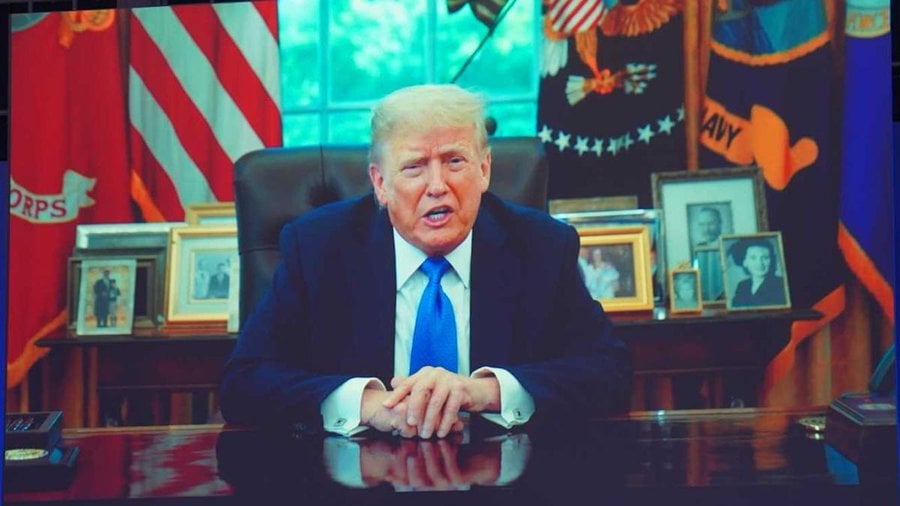
The Genius Act
Trump wasn’t shy about outlining what he sees as his administration’s pro-crypto track record—despite much of it being aspirational at best. He hyped up the GENIUS Act, a piece of legislation aimed at greenlighting dollar-backed stablecoins with state-level support. “We’re working with governors to get the GENIUS Act passed,” Trump said, before pivoting to his broader mission: “to create clear and simple market frameworks that will allow America to dominate the future of crypto and bitcoin.”
That’s a tall order, especially considering the U.S. regulatory environment has been anything but friendly to the crypto industry over the past few years. Still, Trump’s comments come at a strategic moment: the Senate is teeing up a procedural vote on the GENIUS Act, while two House committees just advanced a separate market structure bill. For the first time in years, it looks like Congress might actually move on digital asset legislation—albeit slowly.

Trump talked up his Crypto accomplishments via a pre-recorded message
What the GENIUS Act Really Does: Stablecoins, Finally in the Spotlight
After years of regulatory foot-dragging, the GENIUS Act aims to give stablecoins—those blockchain-based dollars you keep hearing about—their first real legal framework in the U.S.
With the global stablecoin market pushing $232 billion and growing fast, lawmakers have finally decided it’s time to move beyond vibes and tweets. The GENIUS Act introduces a federal blueprint for how these assets should be backed, disclosed, and supervised. It’s less about innovation and more about legitimacy—and yes, it’s a major play to stop regulatory whiplash from killing U.S. crypto innovation.
Here’s what’s under the hood:
Real Backing or GTFO: Every stablecoin issued under this act must be backed 1:1 with U.S. dollars, Treasury bills, or similarly liquid assets. No algorithmic funny business. The reserves must be parked with actual, regulated financial institutions. Think more Circle, less Terra. Who Gets to Issue: Not just anyone can spin up a stablecoin anymore. Only insured banks, their subsidiaries, federally approved nonbanks, or state-regulated players with proper credentials are allowed to issue stablecoins for U.S. users. If you’re not on that list, you’re out of the game. Transparency Rules: Issuers must publish monthly reports showing exactly what backs their tokens. These reports need to be vetted by independent accountants—and personally signed off by the company’s CEO and CFO. Accountability, meet blockchain. Big vs. Small Rules: If you’re issuing more than $10 billion worth of stablecoins, you’re playing in the federal league and will get regulated accordingly. Smaller issuers can stay under state regimes—if their state has “substantially similar” rules in place. Expect that phrase to become a new legal battleground. No Conflict of Interest: In a rare moment of self-policing, the bill bans members of Congress and senior executive branch officials from launching stablecoins while in office. Because apparently someone thought that needed to be said out loud.Perhaps the most eyebrow-raising moment came when Trump claimed credit for creating something that doesn’t technically exist: “We created the U.S. Strategic Bitcoin Reserve and the United States Digital Asset Stockpile.” There’s no official government stash of BTC (yet), but Trump’s framing suggests it’s a matter of “when,” not “if,” at least in his vision.
This pivot is more than posturing—it’s political strategy. Coinbase was a major donor to Trump’s inaugural fund and has already dropped millions into Fairshake, a crypto-aligned super PAC that backed pro-crypto candidates in 2024 and is gearing up for 2026. Trump’s pro-crypto play could be a savvy move to secure further support—and dollars—from Silicon Valley and the growing class of digital asset diehards.

Bitcoin dipped slightly to $107,680, Source: BNC Bitcoin Liquid Index
Following Trump’s message, Coinbase CEO Brian Armstrong and Circle CEO Jeremy Allaire took the stage to make the case that crypto isn’t just a niche—it’s foundational to the future of finance. Allaire, fresh off Circle’s debut on the New York Stock Exchange, recounted how hard it used to be to even get a meeting with institutional players. “I’d walk into a room with an insurance company a decade ago, and they weren’t even sure they were legally allowed to talk to us,” he said.
Fast-forward to today, and that same sector is eyeing crypto as a core infrastructure layer. If Trump’s renewed love affair with digital assets continues—and if Congress actually delivers—this could be the moment the U.S. finally stops fumbling the crypto ball.
But let’s be honest: with Trump, every policy promise comes wrapped in showmanship. Whether any of it materializes is a different story. Still, in a country where politicians have mostly treated crypto like a four-letter word, Trump is out here saying it loud—and, crucially, saying it on video.


 3 weeks ago
15
3 weeks ago
15 



.jpg.webp?itok=1zl_MpKg)





 Bengali (Bangladesh) ·
Bengali (Bangladesh) ·  English (United States) ·
English (United States) ·